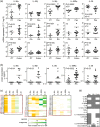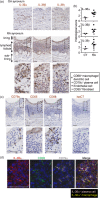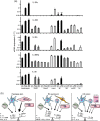Distinct expression of interleukin (IL)-36α, β and γ, their antagonist IL-36Ra and IL-38 in psoriasis, rheumatoid arthritis and Crohn's disease
- PMID: 26701127
- PMCID: PMC4837235
- DOI: 10.1111/cei.12761
Distinct expression of interleukin (IL)-36α, β and γ, their antagonist IL-36Ra and IL-38 in psoriasis, rheumatoid arthritis and Crohn's disease
Abstract
Interleukin (IL)-36α, IL-36β and IL-36γ are expressed highly in skin and are involved in the pathogenesis of psoriasis, while the antagonists IL-36Ra or IL-38, another potential IL-36 inhibitor, limit uncontrolled inflammation. The expression and role of IL-36 cytokines in rheumatoid arthritis (RA) and Crohn's disease (CD) is currently debated. Here, we observed that during imiquimod-induced mouse skin inflammation and in human psoriasis, expression of IL-36α, γ and IL-36Ra, but not IL-36β and IL-38 mRNA, was induced and correlated with IL-1β and T helper type 17 (Th17) cytokines (IL-17A, IL-22, IL-23, CCL20). In mice with collagen-induced arthritis and in the synovium of patients with RA, IL-36α, β, γ, IL-36Ra and IL-38 were all elevated and correlated with IL-1β, CCL3, CCL4 and macrophage colony-stimulating factor (M-CSF), but not with Th17 cytokines. In the colon of mice with dextran sulphate sodium-induced colitis and in patients with CD, only IL-36α, γ and IL-38 were induced at relatively low levels and correlated with IL-1β and IL-17A. We suggest that only a minor subgroup of patients with RA (17-29%) or CD (25%) had an elevated IL-36 agonists/antagonists ratio, versus 93% of patients with psoriasis. By immunohistochemistry, IL-36 cytokines were produced by various cell types in skin, synovium and colonic mucosa such as keratinocytes, CD68⁺ macrophages, dendritic/Langerhans cells and CD79α⁺ plasma cells. In primary cultures of monocytes or inflammatory macrophages (M1), IL-36β and IL-36Ra were produced constitutively, but IL-36α, γ and IL-38 were produced after lipopolysaccharide stimulation. These distinct expression profiles may help to explain why only subgroups of RA and CD patients have a potentially elevated IL-36 agonists/antagonists ratio.
Keywords: Crohn's disease; IL-36; psoriasis; rheumatoid arthritis.
© 2016 British Society for Immunology.
Figures






References
-
- Gabay C, Lamacchia C, Palmer G. IL‐1 pathways in inflammation and human diseases. Nat Rev Rheumatol 2010; 6:232–41. - PubMed
-
- Gabay C, Towne JE. Regulation and function of interleukin‐36 cytokines in homeostasis and pathological conditions. J Leukoc Biol 2015; 97:645–52. - PubMed
-
- Vigne S, Palmer G, Martin P et al IL‐36 signaling amplifies Th1 responses by enhancing proliferation and Th1 polarization of naive CD4+ T cells. Blood 2012; 120:3478–87. - PubMed
-
- Gunther S, Sundberg EJ. Molecular determinants of agonist and antagonist signaling through the IL‐36 receptor. J Immunol 2014; 193:921–30. - PubMed
Publication types
MeSH terms
Substances
LinkOut - more resources
Full Text Sources
Other Literature Sources
Medical
Research Materials

